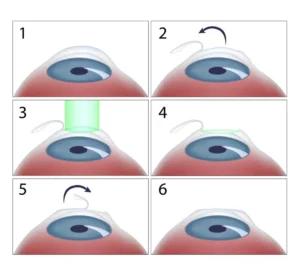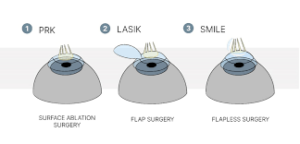Eye Surgery: Laser Types, Recovery and Post-Procedure Care
Click for Quick Consultation at vituras
Waking Up to a Clearer World: Unraveling the Wonders of Laser Eye Surgery
Have you ever dreamt of ditching your glasses or contacts and experiencing the unadulterated joy of unfiltered vision? For millions struggling with refractive errors like nearsightedness, farsightedness, and astigmatism, this dream transforms into reality through the magic of laser eye surgery. This advanced medical procedure is more than just wielding a light beam; it’s a symphony of cutting-edge technology, meticulous precision, and the potential to rewrite your visual perception.
Imagine waking up from a gentle slumber, blinking away the remnants of dreams, and gazing upon the world with newfound clarity. Laser eye surgery doesn’t merely enhance your vision; it paints your surroundings in vivid hues, sharpens distant landscapes, and brings a newfound intimacy to close-up interactions. Picture reading a book without squinting, catching a fly ball effortlessly, or finally recognizing the subtle expressions on your loved one’s face – these are the transformative rewards that laser eye surgery offers.
But how does this technological marvel actually work? The secret lies in the cornea, the transparent dome at the front of your eye. It acts as a lens, focusing incoming light onto the retina, the light-sensitive film at the back. In cases of refractive errors, the cornea’s shape is slightly misshapen, causing light to bend incorrectly and blurring your vision. Laser eye surgery steps in as a meticulous sculptor, gently reshaping the cornea with the precision of a laser beam.
Think of it like chiseling away tiny imperfections on a diamond, each pulse of the laser meticulously adjusting the curvature of the cornea to its ideal form. Different techniques like LASIK, FemtoLASIK, PRK, and SMILE employ this principle, each with its own nuances and advantages. But the underlying magic remains the same – harnessing the power of light to sculpt a path to perfect vision.
However, the journey to clarity doesn’t begin with the laser; it starts with a comprehensive understanding of your unique eyes. Every individual’s visual landscape is a map waiting to be deciphered. Detailed pre-operative examinations, corneal topography scans, and thorough medical history assessments create a personalized roadmap for your vision correction. This meticulous evaluation ensures that the right technique is chosen, tailored specifically to your unique needs and corneal characteristics.
The surgery itself is a marvel of modern medicine, a carefully orchestrated ballet of technology and human expertise. Comforting eye drops and gentle instruments prepare the eye for the laser’s delicate touch. Each pulse is precisely calibrated, meticulously controlled, and monitored in real-time, ensuring every micron of corneal reshaping is executed with flawless accuracy.
But the story doesn’t end with the final laser pulse. Recovery becomes a nurturing process, where your eyes gently adapt to their newfound freedom. Diligent post-operative care, including using protective eyewear, avoiding strenuous activities, and following your doctor’s instructions are crucial steps in allowing your vision to blossom.
In the days and weeks that follow, the world gradually reveals itself in stunning detail. Colors appear richer, shapes become sharper, and distances melt away. The joy of reading without straining, witnessing the sparkle in your loved one’s eyes, or catching a breathtaking sunrise, unfiltered and clear – these are the testaments to the transformative power of laser eye surgery.
While not a magic wand, laser eye surgery is a sophisticated medical marvel, offering a chance to rewrite your visual narrative. It’s a journey from the blurry confines of refractive errors to a world vibrant with detail and unhindered by the limitations of glasses or contacts. It’s about stepping into a future where clarity guides your every step, and the world unfolds before you in a breathtaking panorama of unfiltered beauty. So, if you’re tired of squinting at the world, or yearning for the freedom of unaided vision, take a step towards exploring the wonders of laser eye surgery. Let your eyes become the gateway to a clearer, brighter reality, and wake up to a world where every detail comes into focus.
There are several different types of laser eye surgery, each with its own advantages and disadvantages. The most common types of laser eye surgery are:
- LASIK (laser-assisted in situ keratomileusis): In LASIK, a thin flap is created in the cornea and then lifted up. The underlying corneal tissue is then reshaped with a laser, and the flap is replaced.

- FemtoLASIK: FemtoLASIK is similar to LASIK, but the flap is created with a femtosecond laser instead of a blade. This can make the procedure more precise and reduce the risk of complications.
- PRK (photorefractive keratectomy): In PRK, the entire corneal surface is reshaped with a laser. This procedure typically takes longer to heal than LASIK or FemtoLASIK.

- SMILE (small incision lenticule extraction): SMILE is a newer type of laser eye surgery that uses a femtosecond laser to create a small incision in the cornea. A thin disc of corneal tissue is then removed through the incision. SMILE is typically associated with a faster recovery than LASIK or FemtoLASIK.

The recovery time for laser eye surgery varies depending on the type of procedure. In general, LASIK and FemtoLASIK patients can expect to see well enough to drive and return to work within a few days. PRK patients may need to take a few weeks off from work to allow their vision to fully recover.
After laser eye surgery, it is important to follow your doctor’s instructions for post-operative care. These instructions may include:
- Wear sunglasses to protect your eyes from the sun and wind.
- Use artificial tears to keep your eyes moist.
- Avoid rubbing your eyes.
- Avoid strenuous activity.
Most people who undergo laser eye surgery experience improved vision within a few days of the procedure. However, it is important to be patient and allow your vision to fully recover.
Here are some additional tips for a successful laser eye surgery:
- Do your research and choose a reputable surgeon.
- Be honest with your surgeon about your medical history and any concerns you may have.
- Follow your doctor’s instructions carefully.
With careful planning and preparation, laser eye surgery can be a safe and effective way to improve your vision.
You can also read our article about cold weather and dry eyes.












One thought on “Eye Surgery: Laser Types, Recovery and Post-Procedure Care”